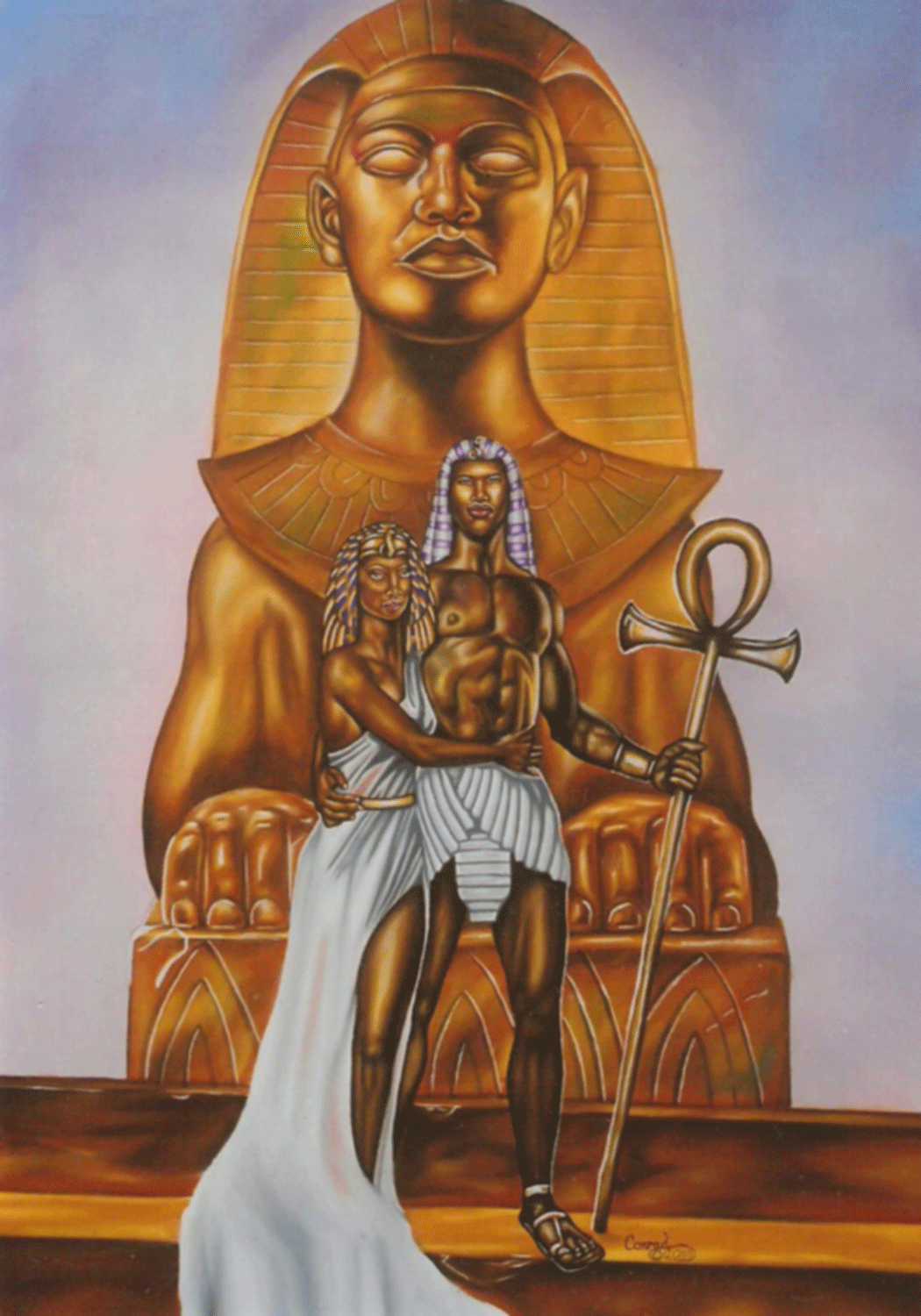11"w x 17"h ready to hang print on wood. The print is designed on a floating mount which gives the illusion it is suspended in mid air once hung.
GUARDIANS OF TRUTH
In various Hollywood movies, children’s books, television shows and other forms of media we see the ancient Egyptians portrayed as Europeans. This portrayal is inaccurate and should be addressed.
The first thing we should note is that Egypt is in Africa. Not the "middle east". The ancient Egyptians, i.e., the pyramid builders, were black people from Africa. These people drew and painted themselves as black or brown people. In fact, the color black was usually reserved for Gods. The beautiful sculptures and massive statues from ancient Egypt clearly depict Black people as the Kings, Queens and majority population of ancient Egypt.
Although there is much controversy amongst Egyptologists and Historians over the exact dates and times relating to the events in ancient Egypt, there is a general consensus regarding the following information:
King Narmer (also known as “Aha” and called Menes by the Greeks) united upper and lower Egypt and founded the first Egyptian Dynasty. This was considered the Old Kingdom and/or Pyramid Age. The world’s first stone building, the stepped pyramid of Saqqara (pronounced Sakkara) was built during the Old Kingdom. This pyramid was built for Pharaoh Zoser (sometimes spelled Djoser, pronounced Joser). The Stepped Pyramid of Saqqara was a precursor of the true pyramid. It was designed by an Egyptian named Imhotep. The three pyramids at Giza in Egypt are perhaps the most popular pyramids in Egypt if not the world. Pharaoh Khufu, who the Greeks renamed Cheops, built the Great Pyramid. King Khafre, the son of Khufu, built the second pyramid and Menkaure, Pharaoh Khafre's son, built the third pyramid. Pharaoh Snefru who was the father of Khufu, built the first true pyramid.
After the Old Kingdom/Pyramid Age, Egypt experienced its first Intermediate Period. This was a period of widespread political upheaval. Pharaoh Mentuhotep II, restored prosperity and stability back to the land when he re-unified upper and Lower Egypt. This period is referred to as the Middle Kingdom or Literary Age because art, literature and religion flourished during this period.
During the Middle Kingdom, Pharaoh Senwosret, aka Sesostris, established a colony in Greece and founded the city of Athens. The first Asian invasion of Egypt by the Hyksos, "rulers of foreign lands", began a period of widespread destruction in Egypt. This was Egypt’s second Intermediate Period.
Once again, it was an African King named Ahmose, who defeated the Hyksos and reunited Egypt. This began what is referred to as the New Kingdom or Temple or Imperial Age. Several important events occurred during the New Kingdom. We shall mention a few:
Pharaoh Hatshepshut ruled Egypt as a female Pharaoh. Amenhotep III, Akhenaton’s father, ruled Egypt at the height of its military power. Queen Tiye ruled by his side. Their son, Amenhotep IV aka Akhenaten, introduced the concept of the Aten as the sole god to be worshipped in Egypt and changed his name from the royal designation Amenhotep IV to Akhenaten. Akhenaten means: "he who is devoted to Aten". His Great Royal Wife was Nefertiti. Nefertiti means, "The beautiful one has arrived". Pharaoh Tutankhamen, better known as King Tut, also ruled during this Dynasty.
After the Middle Kingdom, Egypt experienced its third Intermediate Period. During this time there was a deterioration of political authority and a period of social political and religious decline.
After Egypt's third intermediate period there are several Pharaohs that stand out. Pharaoh Kashta, who brought stability back to much of Egypt, ushered in the Late Period. His successor Pharaoh Piye, aka Pianki, claimed submission from local rulers. Under Pharaoh Shabako and Pharaoh Tirhakah economic prosperity and stability returned to the land. This is the same Tirhakah spoken of in the Bible: II Kings 19, 9 and Isa,37, 9. Tirhakah's successor Pharaoh Tantamani immediately mounted a campaign to control the entire land.
The last period of rulership by native born kemetic kings occurred during the 30th Dynasty. After this period Egypt basically fell under foreign rule and has become the Egypt we know today. Food for thought: The racial make up of the United States is not the same as it was seven hundred years ago. Likewise, the population of modern day Egypt is not the same as it was four thousand years ago...
